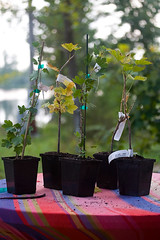Food Forests
 As the summer has begins to move into fall I continue to learn about forest gardening, permaculture, and ecological gardening. Reading a variety of books and websites as well as hands on work in our own gardens, I’m developing a much better understanding of these ideas. I’m no newbie to gardening and have been doing so for the past 20 years, but there’s no doubt that in these past few months I’ve learned a great deal not only about permaculture design but also about the natural processes and systems that our design is meant to mimic.
As the summer has begins to move into fall I continue to learn about forest gardening, permaculture, and ecological gardening. Reading a variety of books and websites as well as hands on work in our own gardens, I’m developing a much better understanding of these ideas. I’m no newbie to gardening and have been doing so for the past 20 years, but there’s no doubt that in these past few months I’ve learned a great deal not only about permaculture design but also about the natural processes and systems that our design is meant to mimic.
The folks over at Edible Forest Gardens offer this somewhat philosophical description of Forest Gardening:
As Masanobu Fukuoka once said, ‘The ultimate goal of farming is not the growing of crops, but the cultivation and perfection of human beings.’ How we garden reflects our worldview. The ultimate goal of forest gardening is not only the growing of crops, but the cultivation and perfection of new ways of seeing, of thinking, and of acting in the world. Forest gardening gives us a visceral experience of ecology in action, teaching us how the planet works and changing our self-perceptions. Forest gardening helps us take our rightful place as part of nature doing nature’s work, rather than as separate entities intervening in and dominating the natural world.
The author of Gaia’s Garden,Toby Hemenway, has this fantastic description of the encounter of western observers of the original food forests:
Until the late 20th century, western anthropologists studying both ancient and current tropical cultures viewed equatorial agriculture as primitive and inefficient. Archeologists thought the methods were incapable of supporting many people, and so believed Central and South America before Columbus—outside of the major civilizations like the Aztec, Maya, and Inca—held only small, scattered villages. Modern anthropologists scouted tropical settlements for crop fields—the supposed hallmark of a sophisticated culture—and, noting them largely absent, pronounced the societies ‘hunter gatherer, with primitive agriculture.’ How ironic that these scientists were making their disdainful judgements while shaded by brilliantly complex food forests crammed with several hundred carefully tended species of multifunctional plants, a system perfectly adapted to permanent settlement in the tropics. It just looks like jungle to the naive eye.
…
The managed forests of the Huastec Maya in northeastern Mexico are packed with up to 300 plant species, including 81 species for food, 33 for construction materials, 200 with medicinal value, and 65 with other uses (the numbers add up to more than 300 since these are multifunctional plants). In these forests, Maya farmers often create different subpatches that concentrate specific guilds of domestic species (such as coffee guilds) amid a background of natives. And all the while, they are tucking small gardens of bananas, chiles, manioc, and other edibles into any clearings. The managed-forest stage may last for 10 to 30 years. Then the cycle begins anew. Since the whole process is rotational, any given area will hold swiddens and fallows at all different phases. This complexity would understandably delude a cornfield-programmed anthropologist into thinking he was looking at raw jungle.